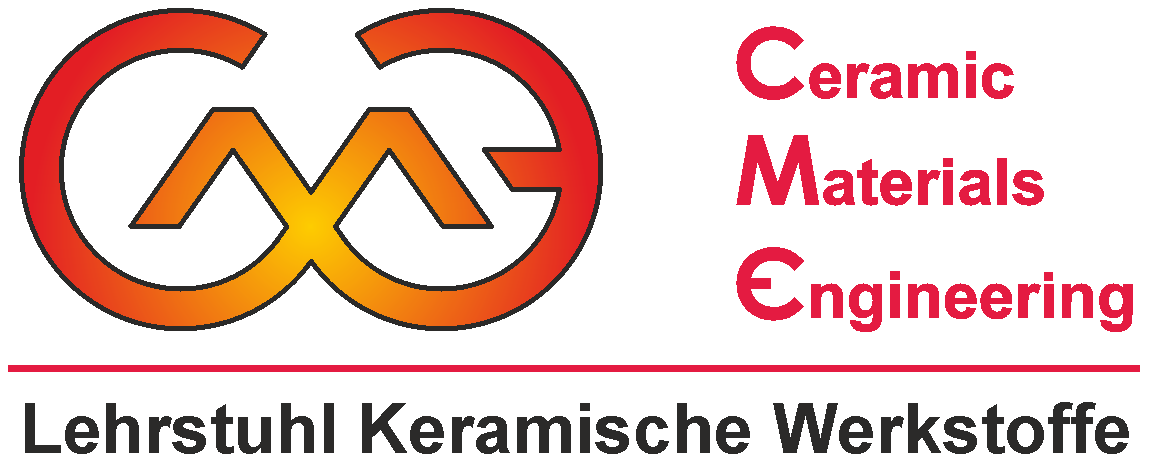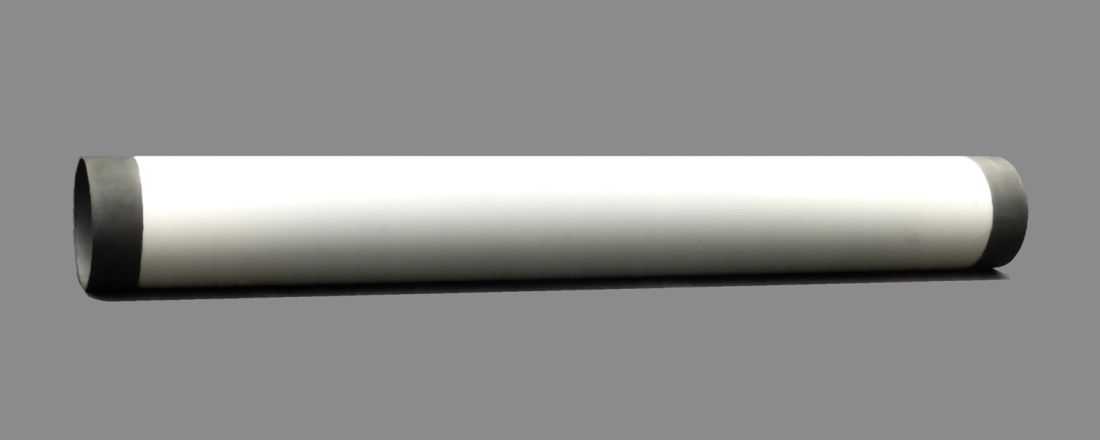Work group "Polymer Derived Ceramics"
Concept
Since the sixties of the last century, so-called precursors, oligomeric and polymeric compounds mostly based on silicon, have been used for the production of ceramics. The main advantages compared to powder ceramics are their processability in plastics technology and the low ceramization temperature. By means of specific thermal post-treatment, the property profile can be adjusted from polymeric to ceramic. Precursors are therefore particularly suitable for the production of thermally and chemically highly resistant polymer and ceramic coatings, ceramic fibers and ceramic fiber composites. The work at the chair includes the synthesis as well as the characterization and processing of organosilicon, ceramizable precursors. The main focus of the activities is the tailored preparation of non-oxide SiCN polymers (polysilazanes), which are synthesized and characterized specifically for the corresponding applications themselves. The further process chain includes crosslinking to duromers, pyrolysis to amorphous ceramics as well as their crystallization combined with the corresponding property characterization of the materials thus obtained. The very demanding basic research required for this is, however, always carried out under the aspect of transferring the results obtained to concrete problems and opening up new areas of application for this class of materials.
- Development of SiCN PrecursorsHide
-
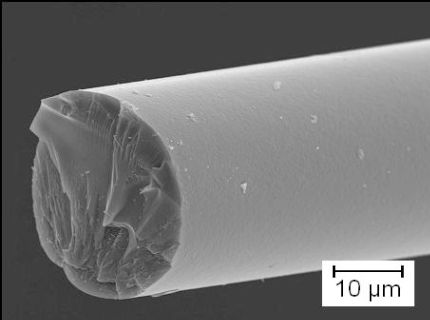
© Lehrstuhl Keramische Werkstoffe
Due to the wide range of applications, it is necessary to develop and synthesize precursors with tailored properties. For processability, the requirements range from very low-viscosity precursors for infiltrations that can be crosslinked by means of a catalyst to solid thermoplastics that soften at temperatures above 100 °C and are very easy to stretch. After molding, conversion to a thermoset is first required. This can be achieved by using certain catalysts, initiators or irradiation. To convert the crosslinked polymer into a ceramic, the highest possible ceramic yield is required after pyrolysis. Smaller precursor quantities or new polymers for experimental purposes are synthesized in-house on a laboratory scale. Otherwise, strategies were developed to tailor commercially available silazanes from Merck KGaA (Darmstadt, Germany) for the corresponding applications by simple chemical modifications.
- Polymeric coatingsHide
-
A major advantage of producing ceramic materials from precursors is the applicability of plastics molding methods. For example, the solid, soluble SiCN precursors can be used to produce solutions that are ideal for coating a wide range of substrates (metals, ceramics, glass, plastics) using simple processes from paint technology (dipping, spraying). In particular, the adhesion of the precursor coatings to plastics, glass and metals with oxidic surfaces is excellent. Modification of the still polymeric, transparent layers leads to strongly hydrophobic (self-cleaning) or hydrophilic (anti-fogging) surfaces. Furthermore, functional properties can be integrated into the coatings by adding suitable fillers. This makes it possible to modify the properties for specific applications such as the protection of metals against salt water corrosion.
- Ceramic coatingsHide
-
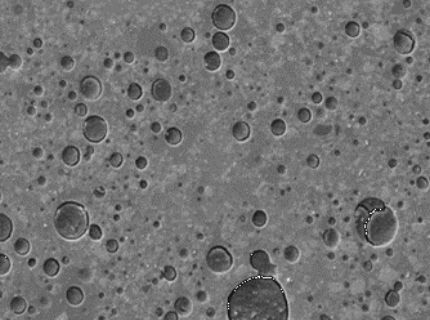
© Lehrstuhl Keramische Werkstoffe
Through appropriate temperature treatment, the degree of ceramization of the coatings can be continuously adjusted to suit the particular application. Therefore, such thin layers can be used for oxidation and corrosion protection of copper and steel or other metals. When developing thick layers, care must be taken to reduce the shrinkage of the precursor layer during ceramization and to match different thermal expansion coefficients between the layer and the substrate. The shrinkage of the layer can be reduced by introducing passive fillers, especially ceramic and glass particles. As a result, layer thicknesses of more than 100 µm can be achieved. A different concept is the use of active fillers. During precursor pyrolysis, these react with the atmosphere or gaseous separation products of the precursor, resulting in an expansion of the filler particles that compensates for the shrinkage of the precursor. The resulting composite coatings are suitable as oxidation and corrosion protection, e.g. for heat exchangers in power plants and as thermal insulation coatings in exhaust systems or turbines.
- Pyrolysis by laserHide
-
The usual way to ceramize a precursor-based coating is thermal treatment in a conventional furnace. This results in the substrate being exposed to the same temperature as the coating. This can be sufficient to cause changes in the microstructure or thermal damage to the substrate. As a result, precursor technology can only be used in combination with high-melting substrate materials such as heat-resistant steels or ceramics. The transfer of silazane-based layer systems on temperature-sensitive or low-melting substrates into a ceramic coating without thermally stressing the substrate can be realized by using laser radiation as an energy source. This enables a locally limited and defined energy input into the coating, minimizing the thermal load on the substrate. Laser radiation produces pore-free, predominantly dense and mechanically as well as chemically stable coatings which are used, among other things, as abrasion protection or corrosion protection.
- Ceramic SiCN fibersHide
-
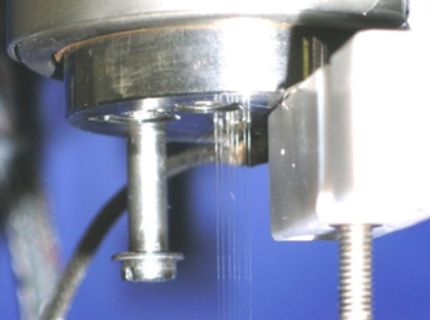
© Lehrstuhl Keramische Werkstoffe
Carbon fibers are still the main material used to reinforce ceramic fiber composites. These are characterized by their excellent mechanical properties and their temperature stability, which, however, can only be guaranteed in an inert gas atmosphere, since noticeable oxidation already starts at 400 °C. Great efforts have therefore been made to develop and manufacture oxidation-stable ceramic oxide and non-oxide fibers. However, only non-oxide ceramic fibers are suitable for application temperatures above 1,300 °C. High-quality oxygen-free SiC ceramic fibers are not available below a price of €3,000/kg, so the high fiber price is also a major drawback for the widespread use of ceramic fiber composites (CMCs). Therefore, in recent years, a process route for the production of ceramic SiCN fibers based on modified commercially available polysilazanes has been developed, resulting in lower-cost ceramic fibers.
After melt spinning, electron beam hardening and ceramization, SiCN ceramic fibers with a variable diameter of 10 to 120 µm are obtained.
The production of thin fibers with diameters of 0.2 to 2 µm is possible via the electrospinning process. Here, the spinning solution is conveyed through a needle, causing the solution to become electrostatically charged. By applying an electrical voltage between the needle and a collector, the solution is accelerated towards the collector. The fibers can be produced as random or aligned fiber bundles. After subsequent ceramization, carbon or SiCN ceramic fibers are obtained, depending on the precursors used.
Hybrid polymers
Copolymers or polymer blends of various organic polymers and ceramic precursors can improve the properties of ceramic fibers made from pure homopolymers. For example, copolymers of polyacrylonitride and polysilazanes significantly increased the oxidation stability of ceramic fibers made from them compared to pure carbon fibers. Currently, various hybrid polymers are being investigated and their properties optimized for different processing methods, such as fiber spinning or 3D printing.
- Porous catalytically active ceramicsHide
-
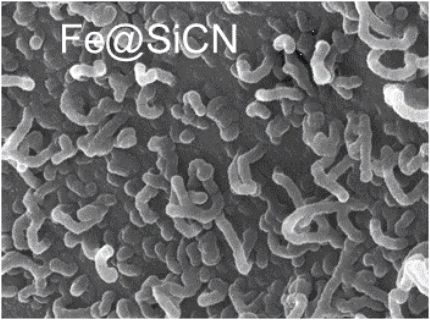
© Lehrstuhl Keramische Werkstoffe
Functional groups of the polysilazanes can be used to chemically bond metal complexes to the polymer backbone. If the metal-modified precursors are actively foamed or combined with pore-forming agents (e.g. PE, PP, PS), a chemically and thermally very stable porous, catalytically active ceramic is formed during pyrolysis. A large number of different metals can be used in this process, so that such materials can be used for a wide variety of catalyses. This research is carried out in cooperation with the Chair of Inorganic Chemistry II (Prof. Dr. Rhett Kempe) at the University of Bayreuth. A new topic is the field of water splitting. The modified polysilazanes can be spinned to fibers what gives them a huge surface area and makes them catalytically interesting. Renewable hydrogen energy produced from water splitting reactions are considered to be the game changer in the upcoming future that targets towards achieving net-zero greenhouse gas emissions. However, in order to perform hydrogen evolution reactions (HER), an effective catalyst is required. The currently existing noble metal based catalysts (Pt, Ir, Rd) limits the large scale production of hydrogen due to the high cost and limited resources. Hence, we attempt to produce a non-noble transition metal based electrocatalysts via. a precursor derived approach.
- Other research areasHide
-
- Development of novel refractory metal-ceramic composites
- Alternative pyrolysis methods using plasma and laser
- Hide

